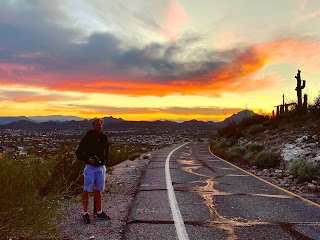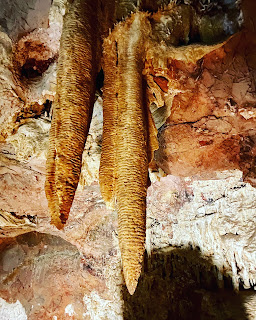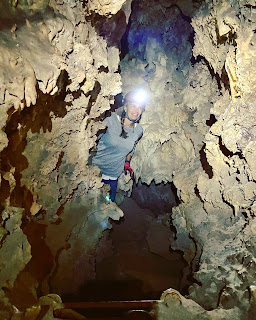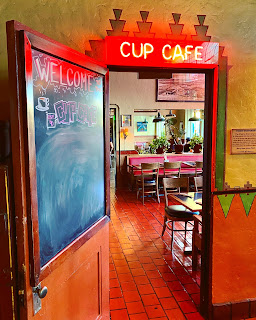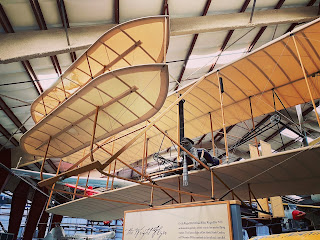On Thursday morning, we started our drive at 9am in the morning. While I have driven to the Colorado River on the border of Arizona many times, once we passed Yuma, it was my first time driving into the interior of Arizona since my family's trip to the Grand Canyon when I was 10 years old. With the hour time change and only a few stops on our 6 1/2 hour drive, we arrived in the city during sunset and parked outside the Franco Apartments at 5:30pm. It was our first time renting an apartment instead of staying at a hotel. After walking around our cute Victorian-style apartment, we decided that we had made the right choice. Not only was it just two blocks from the heart of Downtown, but it was much larger than a hotel room with a separate kitchen and living room and it included a permitted parking spot right on the curb outside.
After unpacking, we walked into Downtown to explore and eat dinner at El Charro Cafe. The two parallel one-way streets that run down the center of Tucson's Downtown are less than a mile long but they were filled with nice restaurants, bars, and theaters with colorful marquees. On the far side, we walked north into the El Presidio Historic District. The Artisans Market had closed at 5pm so we walked over to the nearby El Charro for dinner. We had reservations for 8, but they were able to sit us early ahead of a big crowd of people who begin arriving right after us. El Charro Cafe is known for their Chimichangas so I had to order that, choosing one with their famous Carne Seca, strips of beef that have been slowly sun-dried at the restaurant, then shredded and prepared with chilies, tomatoes and onions. It had an awesome and truly unique flavor that I have never experienced before in Mexican food. Tori thought her Chicken Flautas tasted great! We sat right by the window and drank our Cadillac Margaritas.
After dinner, we walked up the Historic 4th Avenue that sits between the University of Arizona and Downtown, all connected by the electric trolley that runs down the center of the street. The thoroughfare reminded me of Garnet Avenue in Pacific Beach with its young college crowd and the eclectic mix of vintage shops, tattoo parlors, cafes, bars and clubs. The giant Moai Tiki Head at the entrance to The Hut was moved to this outdoor tiki lounge from its previous location at Magic Carpet Golf. We browsed the large selection of used books at the Book Stop and visited the Hippie Gypsie to check out their tye-died shirts, incense and other Bohemian art. We saw a lot of Ice Creams Shops which would be great to visit in this city during the blazing heat of summer. It was a chilly night so we stopped for warm cookies instead at Insomnia Cookies on our walk back to our apartment.
On Friday morning, we woke up early and walked over to the Welcome Diner on Broadway. I really liked the classic 1964 building of this farm-to-table restaurant, that was remodeled in 2016 to highlight the original Googie architecture of Mr. Ronald Bergquist. I had planned to get the Bumblebee Fried Chicken that I had read about in reviews but since that was not served until later in the day, I ended up with the Chicken Fried Steak which is probably the best I have ever had. The Chorizo Gravy on top was delicious and the House Biscuit served with it was amazing. I was still thinking about this meal later in the day.
After walking back from breakfast, we drove out to the Rincon Mountain District of the Saguaro National Park on the east side of Tucson. This section of the park opened in 1950's while the newer section of the park on the West side of the city opened in 1994. After stopping at the Visitor Center, we drove the paved Cactus Forest Loop Drive that winds through the cactus-covered foothills of the Rincon Mountains. While it was easy to see thousands of the iconic Saguaro Cactus on our drive through Arizona to Tucson, it was great to see them in their preserved natural habitat. The tall Saguaro only grows in the Sonoran Desert and can reach heights of 50+ feet and weigh more than 6 tons. The tallest ever recorded was 78 feet but fell down in 1986. The Saguaro grow very slowly with their distinctive arms starting to branch out when they reach 50 to 70 years of age. The average life span is 150 to 175 years but some are known to live over 200. Along the loop, we stopped a few times to hike the short Desert Ecology Trail and climb the Javelina Rocks.
After finishing the loop drive, we left the park to reach the trail head of the Douglas Spring Trail that re-enters the park along the Northern border. The trail to reach the Bridal Wreath Falls was 5.6 miles out and back with 1,072 feet of elevation gain into the Rincon Mountains. (Along with the Saguaros, the desert floor was covered in several types of smaller cacti, including the Chollas, Prickly Pear, and the Fishhook Barrel Cactus with bright yellow fruits sprouting from the top.) On our way up the Douglas Spring Trail, we passed the Garwood, Converse, Carrillo, and the Three Tank Trail before reaching the short 0.2 mile Bridal Wreath Falls Trail that branches off to reach the falls.
After the last long climb up the side of a mountain, we reached a high valley with a noticeably cooler temperature. At this higher elevation, the vegetation changed dramatically with more trees and the Prickly Pear Cactus became the dominant cactus while the amount of Saguaros sharply declined. Near the falls, there was a hitching post for horse back riders that climb this winding trail. We didn't see any horse but we frequently saw their hoof prints in the muddy sections. At the base of the falls, we rested for awhile before heading back down. It ended up taking three hours to finish, returning to my truck at 3:50pm.
After showering and relaxing back at the apartment, we walked into Downtown for our 7pm dinner reservations at Cafe Poca Cosa. We were starving but we had no clue what we were going to eat since this highly regarded restaurant changes its menu twice a day. After seating and ordering margaritas, our server brought us the chalkboard with the ten dishes of the evening written on it and explained them all to us. I ended up ordering the Asada Tomatillo Tocino Guero, a skirt steak cooked with bacon and a tomatillo sauce. Tori had the Pollo Crema Catarina, chicken served with a cream sauce spiced with the Catarina Peppers. The sauces for both of our dishes were so flavorful! We loved them! For dessert, we shared the Flan. After dinner, we drove up to Sentinel Peak to check out the city skyline at night but the gates had already closed at 8pm. Since our apartment had no TV, we just watched a Netflix show synched to both of our iPhones instead. We ended up watching another episode of the show, "Cheer", about the Navarro College Cheerleaders competing for another national championship in Daytona.
For breakfast on Saturday, we drove over to Teressa’s Mosaic Cafe. We had happened to see this restaurant featured on the Travel Channel a year ago and we wanted to try their famous Huevos Rancheros. I think it lived up to it's reputation. After our meal, we headed into the Tucson Mountain Park on the west side of the city. (Tucson Mountain Park, established in 1929, is giant park next to the Saguaro National Park that is managed by the local government instead.) As we crossed the top of Gates Pass, we were surprised by the beautiful views of the large valley below as we descended the steep road. At the center of the valley, we could see the isolated outpost of Old Tucson Studios, a western movie set that also serves as family theme park. The fake town was originally built in 1939 for it's first movie, Arizona (1940), and than served as the location for many other movies such as Gunfight at the O.K. Corral (1957), Rio Bravo (1957), Three Amigos (1986) and TV shows like Bonanza, Gunsmoke, and Little House on the Prairie. The most recent movie that I have seen was the The Quick and the Dead (1995) with Sharon Stone, Leonardo DiCaprio, Russell Crowe and Gene Hackman.
Passing Old Tucson, we continued on to the Arizona-Sonora Desert Museum deeper in the park. Containing a zoo, aquarium and botanical garden, this facility is much more than just a natural history museum. Arriving at 9:30, we were just in time for the Raptor Free Flight starting at 10am. I have been to several bird shows in the past but I think this one is the best. Instead of sitting in bleachers set back away from the stage, we stood along a narrow path between the perches of the flying raptors. Because the large birds fly so low over our heads as they cross back and forth between the trees on either side, we were asked to not raise our hands above our face. I could feel the wind beating under their wings as both the Great Horned Owl and the Ferruginous Hawk flew less than a foot over my head.
After the free flight demonstration, we finished the half mile Desert Loop Trail within the museum checking out the Javelinas and Coyotes napping in the winter sun. (The Javelina looks like a small wild boar but they are a different species called the peccary that is native to the Americas as opposed to pigs that were brought over from Europe.) We visited a few of the other exhibits, including the Walk-In and Humming Bird Aviaries before leaving at 11:30.
Only a few miles up the road, we entered the Saguaro National Park and stopped at the Red Hills Visitor Center to learn about the different trails in the western half of the park. After our long hike the day before, we wanted a shorter distance so we decided on the suggested 3.5 mile Sendero-Esperanza Trail after driving the Scenic Bajada Loop Drive. Unlike the paved Cactus Forest Loop in Saguaro East that is popular with cyclists, this loop is a well-groomed dirt road instead. When we reached the back half of the loop, we turned and followed Golden Gate Road to the trailhead at the end of the road. The trail was mostly flat for the first mile, and then it started climbing fairly steeply in a series of switchbacks to the ridge-line of the Tucson Mountain Range.
At the top, we reached the trail junction that crosses paths with the Hugh Norris Trail. That longer trail follows the ridge-line all the way up to Wasson Peak, the highest point in the park at 4,687 feet. Looking down the other side of the narrow ridge, we could see our Sendero-Esperanza Trail winding down to meet the Gould Mine Trail that has its trailhead near the entrance of the Arizona-Sonora Desert Museum that we could see far off in the valley. After enjoying the beautiful panoramic view, we turned around and headed back the way we came.
On our drive back through the Tucson Mountain Park, we stopped at Gates Pass Overlook that we had passed in the morning. We hiked up the short distance to one of the two stone huts built by the Civilian Conservation Corps (CCC) in the 1930's during the Great Depression. Though defaced with graffiti on the inside, it sits perfectly perched at the steep edge of the mountain pass with wonderful views of the park and Old Tucson in the distance. Despite this being the desert, the density of green cacti in the valley floor below gave it a lush green appearance. We could see several hiking trails crisscrossing the area. With it's western views, this would be a great spot to watch a sunset.
Driving 10 miles South of Tucson, we entered the San Xavier Indian Reservation to visit the Mission San Xavier Del Bac. This historic Spanish Colonial Mission was founded by the Jesuits in 1692 but the original church was burned during an Apache Raid in 1770. When the King of Spain banned the Jesuits from his colonies in the New World, the mission was given over to the Franciscans who built the current church between 1783 and 1797 with the labor of the local Native Americans. When Mexico became independent in 1821, the mission fell under the jurisdiction of Mexico City and the government soon banned all Spanish-born priests. After the last Franciscan left in 1837, the church became vacant and began to decay. After the Gadsden Purchase in 1853 when the area became part of the United States, the church reopened and began repairs in 1859. The mission was declared a National Historic Landmark in 1963 and underwent extensive restoration afterward to return it to its original state. Unlike other historic missions in Arizona, this mission is still actively run by Franciscans and holds regular services for its community.
After walking through the ornate interior of the Mission, we stopped by one of the many stands outside serving Indian Fry Bread. Tori had hers topped with Powdered Sugar while I tried one with Cinnamon Sugar. We would have ordered a larger Indian Taco as well but we were on way to El Guero Canelo at their South 12th Avenue location to try one of their famous Sonoran Hot Dogs, a bacon-wrapped frank served with beans, onions, tomatoes, mayo, mustard and jalapeno sauce. I especially liked the Mexican-style Bolillo Roll that the hot dog is served inside. It was delicious and I would have ordered two but I wanted to save room for a later dinner. (Tori ordered a children's burrito and said it was the best Pollo Asada she has ever had!) I also took a bite of the roasted Guero Pepper they served on my plate and I recommend it to Tori. She took a bite as well before my mouth started burning. Luckily, while the heat was intense, it was short lived. I enjoyed the live band playing music under the patio while we ate. In 2018, this restaurant received the James Beard Award for the American Classics category.
Since the Sentinel Peak Overlook was closed the night before, we headed straight there after eating and arrived at 5pm, about 45 minutes before the sunset. We found a nice parking spot right beneath the giant "A", the 160 foot-tall letter that gives the hill it's other name, "A" Mountain. It was created in 1916 by students of the University of Arizona out of basalt rock and a thick coat of white paint. The original name of the hill was based on its role as a sentinel station that kept a watch for Apache raids. From our parking spot on the road, we had a great view of Downtown Tucson and the surrounding city.
As the sun dipped behind us, it illuminated the Santa Catalina Mountains and Rincon Mountains to the East with a orange and pink glow. I climbed to the top of the "A" and continued on to the 2,897 foot peak where I could see Tumamoc Hill nearby on my right as I watched the sun disappear behind the Tucson Mountains on the west side of the city. After I climbed back down, Tori and I walked along the circling road so she could see the sunset from the other side of the hill as well. We stayed until the sky completely darkened and the city lights came on.
After relaxing in our apartment for a little while, we went out to eat dinner at 8pm. Walking over to Fourth Avenue, we decided to eat at Ermano’s Craft Beer & Wine Bar. We weren't super hungry since we ate at 4:30 so we decided to share the Kale Salad and Nachos with a couple glasses of wine. Both were really good! The nachos were pretty unique for us since we have never had them served with Smoked Gouda instead of Cheddar or Jack Cheese before.
We were super tired when we woke up on Sunday morning. We had a morning tour scheduled so we dragged ourselves out of bed and walked a couple blocks to Cartel Coffee for espressos and pastries. I was so out of it that I forgot my credit card in the chip reader but I ended up getting it back. We felt much better by the time we arrived at the Colossal Cave Mountain Park for our Ladder Tour. This cave system with 3.5 miles of mapped passageways in the Rincon Mountains was slowly created by flowing water opening up passages in the rock and decorating them with limestone deposits to create the stalactites and stalagmites. Eventually the water source moved away and the Colossal Cave dried out so the formations stopped growing. While there is evidence that the natives used the entrance area as a temporary shelter from 900 to 1450 AD, the cave entrance was re-discovered by Solomon Lick in 1879 while searching for stray cattle. In the early years, it was used a hideout for train robbers and mined for bat guano.
After our guide outfitted us with lighted helmets, we put on our gloves and entered the cave. It was a little smelly since a family of raccoon-like Coati live near the entrance, but it soon dissipated as we went deeper into the cavern. Since we were on the longer Ladder Tour, we quickly diverged away from the regular tour path to cross over narrow ledges, squeeze through tight passages and climb down the skinny ladders built by the Civilian Conservation Corps (CCC). During the Great Depression, the workers camped in tents outside and installed the lighting, walkways and handrails inside the cave as well as building the stone buildings and patio outside the entrance. Since anything over 50 years is considered historical, all the items they left in the cave have to remain in place, including old water barrels and other rubbish they may have left behind.
In one of the small caves, our guide let us freely crawl around and explore all the small side passages. Further along, she led us up a sloping dead-end passage where we turned off our lights and experience the total blackness deep under the earth. She explained how our eyes need light to exercise the pupils and stay healthy. Miners and others who have been trapped in caves for a long time can suffer permanent damage to the eyes even if they have access to working flashlights. She surprised us by announcing that we were now going to crawl back down the passage in the dark. Scooching down the pitch black tunnel on our butts was my favorite part of the tour. Even though the roof of the passage was high over my head, I kept waving my hand in front of my face to protect it. Sesame Street once filmed here in the cavern and she showed us the T-Rex Rock and the Big Bird shaped hole in the the passageway that they utilized to tell their story of the puppets exploring the caves. We also got to tap a few of the rock formations that emitted the sound of a vibrating drum. For most of the tour I kept thinking that there were not that many ladders, only 2 or 3, but it turned out they were saving the majority of them for the end. It was fun climbing several series of ladders as we made our way back up through the caves to the entrance.
Next time we come back, I want to book the 3.5 hour Wild Cave Tour that explores the other half of the cave system. They have an Intermediate and Advanced version. I enjoyed checking out the cave map in the gift shop that showed the different colored routes for each tour. After the cave tour, we walked one of the short trails overlooking the surrounding valley and checked out the the small hut the stood at the top of the mine shaft used by the CCC. Since we only had a pastry for breakfast, we were looking forward to stopping at Tucson Tamale Company for lunch on our drive back. Our favorite tamale was the "Green Chili and Cheese", but we also enjoyed the wide variety. Tori also ordered the "Blue Corn Veggie and Cheese" while I had the "Chipotle Beef and Cheese" and the "Black Bean and Cheese".
Before we left for our trip, we checked to see if there were going to be any AcroYoga Jams in the city of Tucson while we were here. It turned out the Facebook group gets together a couple hours before sunset every Sunday at Armory Park just three blocks from our rented apartment so we decided to go. After I finished stretching, we walked over to join the AcroJam on the grass. They were a very welcoming and friendly group. Alexis and Jake taught us a new washing machine called "Festival". There was a tricky transition step in the middle of the machine that was pretty hard but I managed to catch on to it on my 5th attempt. We also met Chris who brought his drone to practice filming so we worked on a flow as it buzzed overhead. (Vimeo Drone Footage) It also filmed directly above as I participated in a fun group activity where 4 bases spun 4 flyers around in a circle. We couldn't seem to get it down completely since our feet at the center kept getting tangled up after a few rotations. They were more successful with another where 3 bases held 3 flyers overhead in a connected circle as they spun around. It looked dizzying! Before we left the park at 6pm, we saw a hawk catch a small bird in mid-air.
We wanted to try the local Raspados, a Mexican-style shaved ice drink, before dinner so we boarded the Sun Link Street Car running through Downtown to visit the Mercado San Agustin. Stepping out at our destination, we realized we were standing right next to the large tent of the Zoppé Circus as they were announcing the Flying Trapeze Act. We saw the three flyers walking past as they prepared to enter the big top. When we discovered that Sonoran Sno-Cones had closed early in the Spanish courtyard market, we walked down the street to Sonoran Delights instead. We ended up ordering a Sour Raspados that is spiked with a pungent pickled fruit sauce called Chamoy. We chose the Fresada flavor (Strawberry) that came topped with Rielitos, a sour Tamarind Candy. I remember disliking these candies as a kid so I was surprised to find that I enjoyed them now with my adult taste-buds. After finishing our refreshing treat, we walked back just in time to catch the last street car of the night back to Downtown.
We loved the food at Welcome Diner so much, we decided to walk back there for our last dinner in the city. We had both planned to have the Chicken and Biscuits that we attempted to order on Friday morning but I ended up changing my mind to the Chicken and Dumplings. The spice from the Poblano peppers made it a perfect soup. It was so tasty that I found myself closing my eyes to savor the flavors several times. Tori stuck with the plan and picked the Lil Birdy, fried chicken served with cheddar on one of their awesome biscuits. We shared the Pecan Pie made with Arizona grown pecans and a corn meal crust. It was so delicious!
We woke up again early on Monday, our last day in Tucson, and walked over to breakfast at the Cup Cafe in the Congress Hotel. I had the tasty Barrio Toast, their version of avocado toast, while Tori ordered the Brioche French Toast. After walking back, we packed up and loaded the truck before heading to Pima Air and Space Museum.
We had an hour to explore the Pima Museum before boarding the bus for the AMARG "Boneyard" Tour at the Air Force Base next door. The recreation of the Wright Flyer near the entrance was very cool. Some of the favorite planes I saw in the main hanger were the F-14A Tomcat, made famous from "Top Gun", the SR-71A Blackbird which holds speed and altitude records and the PBM-5A Mariner, with giant wheels that fold up into the sides so it could land on the water. They also have the Starr Bumble Bee which held the record for the smallest plane in the world with a 6 foot, 6 inch wingspan.
In the huge lot outside, we saw a lot more nimble fighters, giant strategic bombers and historic commercial aircraft, including several planes that served as Air Force One. From NASA, they have the "Vomit Comet", a KC-135A Stratotanker that was used to train astronauts in weightlessness and the "Super Guppy", a Aero Spacelines 377G with a bulbous cargo hold that was used to transport rocket segments, including the Saturn rockets from the Apollo program. One of the smaller hangers on the grounds holds the separate 390th Memorial Museum with a B-17 Flying Fortress that were heavily used in the beginning of World War II before larger bombers with jet engines took over. My grandfather was a U.S. Marine Pilot in World War II and the Korean War, so I kept my eye out for the Douglas A-24 "Dauntless", the Dive Bomber he flew in the Pacific Theater of WWII, but I didn't see it during our short visit. (Update: 4/20/20 - I looked up the plane on the museum's website and I found out they do have one. I will have to check it out next time.)
At 10:45 we lined up outside the bus for the tour of the "Boneyard", aka the 309TH Aerospace Maintenance and Regeneration Group (AMARG) Facility. We saw several "Warthogs", the nickname for the A-10 Thunderbolt, taking off and landing repeatedly on the nearby runway of the Davis-Monthan Air Force Base as we waited to board. Security was tight at the gate as we had to disembark so they could search the bus before letting us back on. We drove down the many lanes of mothballed planes from the U.S. Air Force, Navy-Marine Corps, Army, Coast Guard and our NATO allies. The facility is used for it's dry climate to store planes for future use or to provide spare parts to planes in active service. Since the landing gear is part of the plane that needs the most replacing, we saw a lot of planes sitting on wooden struts after they had been removed. When the planes or helicopters arrive for storage, they have the classified hardware and ejection seat charges removed before cleaning the aircraft and draining the fuel systems. The aircraft are them coated twice with Spraylat, a black layer to seal up the openings and a white layer to reflect the heat from the sun. The facility also holds 365 Boeing B-52 Stratofortress bombers that had to be removed from service according to the START treaty with Russia. The dismantled planes must be visible to Russian satellites flying overhead.
Arriving back at the Pima Museum at 1pm, we started our seven hour drive home to San Diego. On the northern outskirts of Tucson, we stopped at the local sandwich chain, Baggin’s Gourmet, for lunch. I had the Prime Baggin's, a roast beef sandwich with cream cheese, while Tori had the Albuquerque Turkey, the grilled turkey sandwich with BBQ sauce. We had a great time in Tucson and I would definitely visit again. There was a lot of places that I wanted to see that we didn't have time to fit in, including Sabino Canyon, the Biosphere 2 and the University of Arizona campus. It would be cool to visit the nearby town of Tombstone as well.









































































